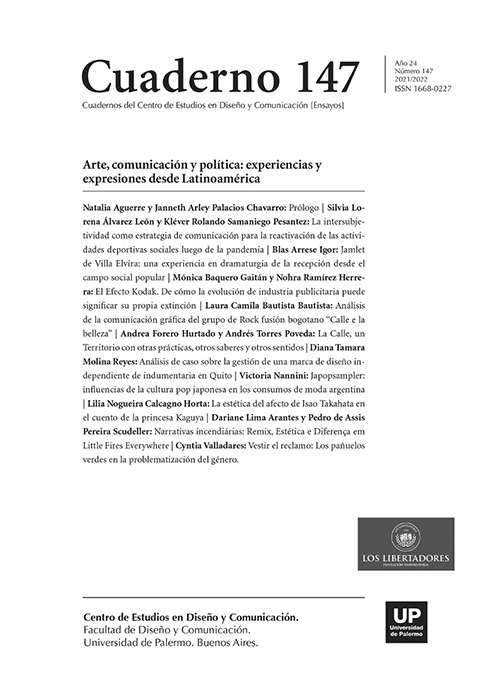Análisis de la comunicación gráfica del grupo de Rock fusión bogotano “Calle e la belleza”
Abstract
This article will reflect on the findings of the research carried out on the analysis of the form of graphic communication of the Bogota Rock fusion group “Calle e la belleza”, from its birth in 2014 to 2020. The choice of this group is due to the fact that it can be observed how this type of music is closely related to urban youth culture, and how its graphic communication establishes its cultural identity through the exchange of knowledge, practices and representations about the daily reality of the city. The research carried out had a qualitative approach, since it analyzed reality in the natural context, interpreting from data collection, without numerical measurement. Assuming qualitative research requires not only understanding but also being able to capture details that might be irrelevant seen from other areas, that is, understanding that the other person or other people want to express through their words, their silence and actions, all through interpretation and dialogue. The main purpose of the research is to determine if the communicational process mediated by costumes, visual art, letters and graphic resources that the group raises, are in accordance with what it projects, from the appropriation and creation of fusion music to cultural development to make the symbolic structure and its own discourse a medium of expression.
References
Acaso, M. (2011). El lenguaje visual. Barcelona, España: Ediciones Paidós.
Bauman, Z. (2017). Retropía. Barcelona, España: Ediciones Paidós.
Calle 'e la Belleza. (8 de marzo del 2018). El Viajero Espacial (Video oficial) [Archivo de Vídeo]. Youtube. https://www.youtube.com/watch?v=rGMhnCmp52s
Calle 'e la Belleza. (11 de enero del 2020). Invasión cerebral (Audio Oficial) [Archivo de Vídeo]. Youtube. https://www.youtube.com/watch?v=9ze40GE-yLk
Calle 'e la Belleza. (8 de octubre del 2018). Bazar Calle'ejero - Calle 'e la Belleza [Invitación crowdfunding] [Archivo de Vídeo]. Youtube. https://www.youtube.com/watch?v=9ze40GE-yLk
Eco, U. (2018). Tratado de semiótica general. Miguel Hidalgo, Mexico: Penguin Random House.
García Jímenez, E. (1996). Metodología de la investigación cualitativa. Granada, España: Ediciones Aljibe.
Gímenez, G. (2009). Identidades Sociales. Ciudad de México: Col Intersecciones.
Martin Barbero, J. (2002). La educación desde la comunicación. Bogotá, Colombia: Norma.
Martínez, Á. & Ríos, F. (2006). Los conceptos de conocimiento, epistemología y paradigma, como base diferencial en la orientación metodológica. Cumaná, Venezuela: Moebio.
Martínez, M. (1991). La investigación cualitativa etnográfica en educación: manual teórico-práctico. Ciudad de México: Trillas.
Maxwell, J. A. (1996). Qualitative Research Design: An Interactive Approach. Oklahoma, Estados Unidos: Sage Publications, Inc.
Moles, A. & Costa, J. (2005). Publicidad y diseño: El nuevo reto de la comunicación. Ciudad de México: Trillas.
Morse, J. (2012). Investigación en salud cualitativa: creación de una nueva disciplina. Walnut Creek, Estados Unidos: Routledge.
Munari, B. (1983). ¿Cómo nacen los objetos? Barcelona, España: Gustavo Gili S.A.
Ricoeur, P. (1969). El conflicto de las interpretaciones. Buenos Aires, Argentina: Fondo de Cultura Económica.
Rodríguez Sabiote, C. (2003). Nociones y destrezas básicas sobre el análisis de datos cualitativos. Seminario Internacional titulado: El proceso de Investigación en educación. Santo Domingo, República Dominicana.
Ruiz, J. I. (1989). La descodificación de la vida cotidiana: métodos de investigación cualitativa. Bilbao, España: Universidad De Deusto.
Serrano, M. M. (1982). Teoría de la comunicación: Epistemología y análisis de las referencias. São Paulo, Brasil: Corazón Editor.
Sierra Bravo, R. (1984). Técnicas de investigación social: teoría y ejercicios. Madrid, España: Paraninfo.
Van Dijk, T. (2005). Ideología y análisis del discurso. Barcelona, España: Utopía y Praxis.
Verón, E. (1987). La palabra adversativa. Buenos Aires, Argentina: Hachette Livre.
Vilchis, L. d. C. (2006). Relaciones dialógicas en el diseño gráfico. Ciudad de México: ENAP.
Weilbacher, W. (2001). El Marketing de la Marca: Como Construir Estrategias de Marca Ganadoras Para Obtener Valor y Satisfacción Del Cliente. Barcelona, España: Granica.
Los autores/as que publiquen en esta revista ceden los derechos de autor y de publicación a "Cuadernos del Centro de Estudios de Diseño y Comunicación", Aceptando el registro de su trabajo bajo una licencia de atribución de Creative Commons, que permite a terceros utilizar lo publicado siempre que de el crédito pertinente a los autores y a esta revista.


